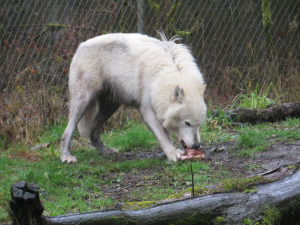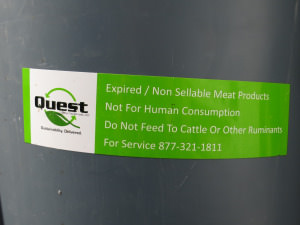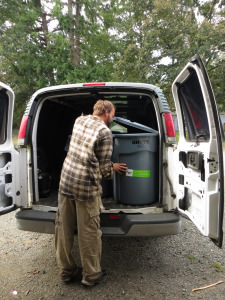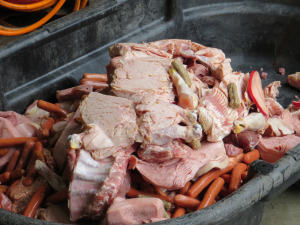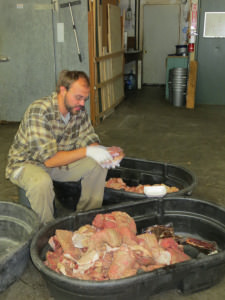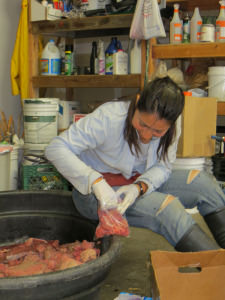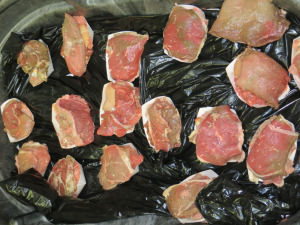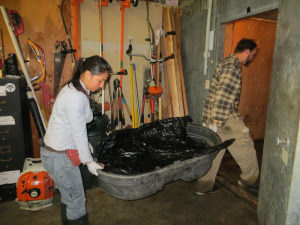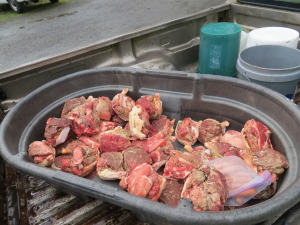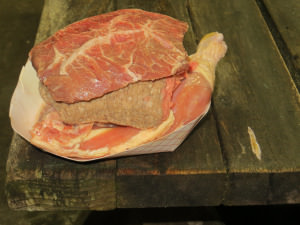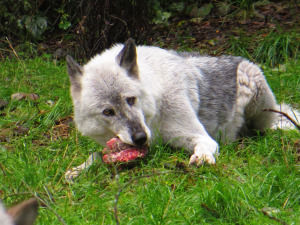(Or How to Make a Meat Loaf for a Wolf)
by Wolf Haven Animal Care Specialist Brennan Stoelb
If you’ve come to Wolf Haven for a visit, you know that certain parts of the days the wolves are less active than others, just as they would be in the wild. If you happen to be here when Animal Care feeds, you know that even the sleepiest wolf will perk up when they hear the truck!
What we feed the wolves is a very popular topic among pretty much everyone I talk to when Wolf Haven is mentioned. Since wolves in the wild live a “feast or famine” lifestyle, we mimic this with two bulk feedings a week. Our two bulk feedings consist of scrap beef on Tuesdays and whole chickens on Fridays. We also do smaller feedings, turkey necks as an example, throughout the week. On average, each wolf is fed 20 pounds a week. This keeps the wolves at their ideal weight, around 100 pounds. Aside from the road-kill, salmon, and enrichment items, Wolf Haven purchases the majority of our meat from a local butcher.
Earlier this year, Wolf Haven was contacted to partake in a program called Sustainable Solutions through Quest Recycling. The goal of the program is to reduce waste that food vendors produce, in this case unsold meat. Normally, the unsold meat would go to a landfill or a rendering plant. At a rendering plant, the meat would be turned into dog food, soap, and even a component in make-up. The waste disposal would come at a cost to the food vendor. Animal facilities, such as Wolf Haven, have a need for meat which can be costly. Through Sustainable Solutions, both party’s needs are met, while cost and waste can be reduced.
Every Friday at 11:30, Pamela and I load up the van with empty barrels and head to our food vendor to pick-up our meat at noon. We exchange our empty barrels for full ones, usually three or four, sign some paperwork and get on our merry way! When we arrive at Wolf Haven the fun really begins.
The meat we get and the amount varies week to week, due to whatever the consumer purchases or doesn’t purchase that week; however, these barrels are often very heavy. A full 44 gallon barrel was weighed a few weeks ago at a whopping 400 pounds. Our vendor typically puts like meat in the same barrel, ground beef and steak for example. There is also a chicken barrel that has chicken wings, breasts, thighs, drumsticks, boneless, quartered, and whole chickens.
The most interesting barrel is labeled “other” which contains ham, pork, hotdogs, spiced sausages, bacon, bologna, just to name a few. Once a barrel’s contents are identified, we empty the contents into tubs for further sorting.
We try to utilize as much of the meat as possible, however there are things we do not use. We use ground beef for pilling media, so we place roughly a day’s worth in sandwich bags. Kiawatha is notoriously finicky when it comes to taking her pills. Her favorite is roast beef, so we set aside roast for her.
Hotdogs, while not a staple of the wolves’ diet, serves as a nice morning treat for everyone while Animal care does the walk-through, so we set aside around 100 to get us through the week. Things we do not use, such as bacon, ham, and spiced meat, are too high in sodium and fat.
It is often joked that the wolves eat better than the humans on staff, and certainly in the case of loaf, it’s true! Loaf is a combination of ground beef, chicken and steak. We take the paper tray and put in a layer of ground beef. Next, a piece of chicken. To top it off, we add a nice piece of steak. The total weight per loaf is around two pounds.
Once we have enough made for everyone in the sanctuary, plus a couple extra, we place the tubs in the freezer. Freezing the loaf not only makes it easier for us to feed it out, but it acts as an enrichment item that the wolves have to gnaw on and spend more time with, rather than “wolfing” it down. You can imagine that during the hot summer days, a nice meatsicle will also cool you down!
Thursday is our loaf feeding day, though depending on the amount of good meat we have, we may be able to do two days a week. When we feed loaf, we load the tubs on the back of the truck and toss the meal to eager mouths.
While the meat we receive from the Sustainable Solutions program doesn’t eliminate all of our meat costs, it certainly helps. As a conservation organization, we are happy to be a part of program that reduces waste.
Bon Appétit!

